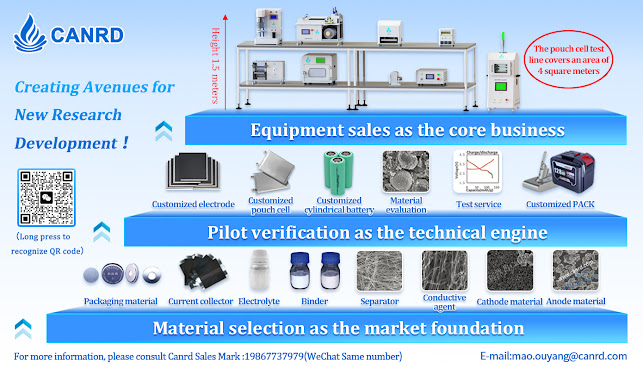Single-sided pole piece manufacturing method
This issue introduces the production process of single-sided pole pieces to help you obtain satisfactory data results in experimental tests.
1. Stirring
The first step is the preparation of the slurry. The equipment used are "high-speed variable frequency mixer" and "beaker".
High speed variable frequency mixer
http://www.canrd.com/shop/product/getProductById?id=70181bae88854c448709d2bd94ddfc8b
http://www.canrd.com/shop/product/getProductById?id=569dd0f0ab084e5faa9df8a3014d196c
The first step is to glue, that is, the solvent and the adhesive are mixed first. The standard for good dispersion is that the glue liquid is clear and transparent without obvious agglomeration. The generally used stirring parameters are: speed 1500rpm, time 2h (the speed and time can be increased according to the glue liquid situation).
Then, the conductive agent is dispersed. Add the conductive agent to the glue liquid, stir slowly to mix the conductive agent into the glue liquid to avoid powder splashing, and then stir quickly to disperse. The commonly used stirring parameters are: speed 1500rpm, time 3h (the speed and time can be increased according to the dispersion situation). The dispersion standard is oil system fineness <20um, water system fineness <60um, and use a "scraper fineness meter" for measurement. When using, drop the slurry on the 100um scale, use a scraper, perpendicular to the fineness meter, and scrape it down at a uniform speed above the slurry (do not put it directly on the slurry), and read the scale where scratches or particles appear, which is the slurry fineness.
http://www.canrd.com/shop/product/getProductById?id=7e775681f406472f850525210ac86afb
Then disperse the active substance and add it to the dispersed slurry. Stir slowly first and then stir quickly. The stirring parameters generally used are: speed 1500rpm, time 2h (speed and time can be increased according to the dispersion situation). The dispersion standard is positive electrode fineness <10um, negative electrode fineness <20um (need to check the particle size of the material itself, large particles will not meet the fineness requirements, and the standard needs to be adjusted according to the actual situation).
Finally, the viscosity of the slurry needs to be adjusted. The general viscosity range is 4000-6000mPa·s for the positive electrode and 2000-4000mPa·s for the negative electrode. The equipment used is a "viscometer" and the parameters used are: rotor No. 3, 6 rpm. Read when the reading is stable to obtain the slurry viscosity data. It should be noted that the opening angle is generally normal at 20%-80%. If it exceeds this range, the rotor or speed needs to be adjusted. Then use a "stainless steel screen" to sieve the slurry to filter out large particles and obtain a slurry that can be used for coating. Generally, the positive electrode is sieved with 200 mesh and the negative electrode is sieved with 150 mesh (the mesh number can be adjusted according to the fineness of the slurry).
http://www.canrd.com/shop/product/getProductById?id=8a5a4551634e45bab5a3c8c220792e3d
http://www.canrd.com/shop/product/getProductById?id=67320a4a82054ea49fc7e5eea8eb7f5b
2. Coating
The second step is to start coating, and the tools used include: "current collector", "adjustable applicator" and "metal scraper".
http://www.canrd.com/shop/product/getProductById?id=d65df81681ad46feab5cfc99ff8f98b1
http://www.canrd.com/shop/product/getProductById?id=adc02e8d0c0a431ea20bdaad93746059
First, cut the current collector into a suitable size, and then spread it flat on the metal scraping board. Use alcohol to smooth the current collector so that it fits the metal scraping board tightly. Then add an appropriate amount of slurry on top, adjust the gap of the adjustable film applicator (adjust according to the required surface density), place the film applicator on the empty foil above the slurry (not directly on the slurry), and scrape it down at a uniform speed. Remember to try to ensure that the amount of slurry added each time and the scraping speed are consistent, so that the coated electrode can be uniform.
Then put the coated electrode into a blast drying oven for drying, generally at a temperature of 85-110°C, and the time is generally about 5 minutes (determined by the coating thickness of the electrode).
In this way, a single-sided electrode can be obtained, and then this electrode can be used to make a button battery or a single-chip battery to test the relevant electrochemical properties. I hope this article can help teachers and students.
Finally, I wish all teachers and students success in their scientific research.
Canrd Brief Introduce
Canrd use high battery R&D technology(core members are from CATL) and strong Chinese supply
chain to help many foreign companies with fast R&D. We provide lab materials, electrodes, custom
dry cells, material evaluation, perfomance and test, coin/pouch/cylindrical cell equipment line, and
other R&D services.
Email:contact@canrd.com
Phone/Wechat/WhatsApp:+86 19867737979
Canrd Company Vedio/Website:www.canrud.com
















No comments:
Post a Comment